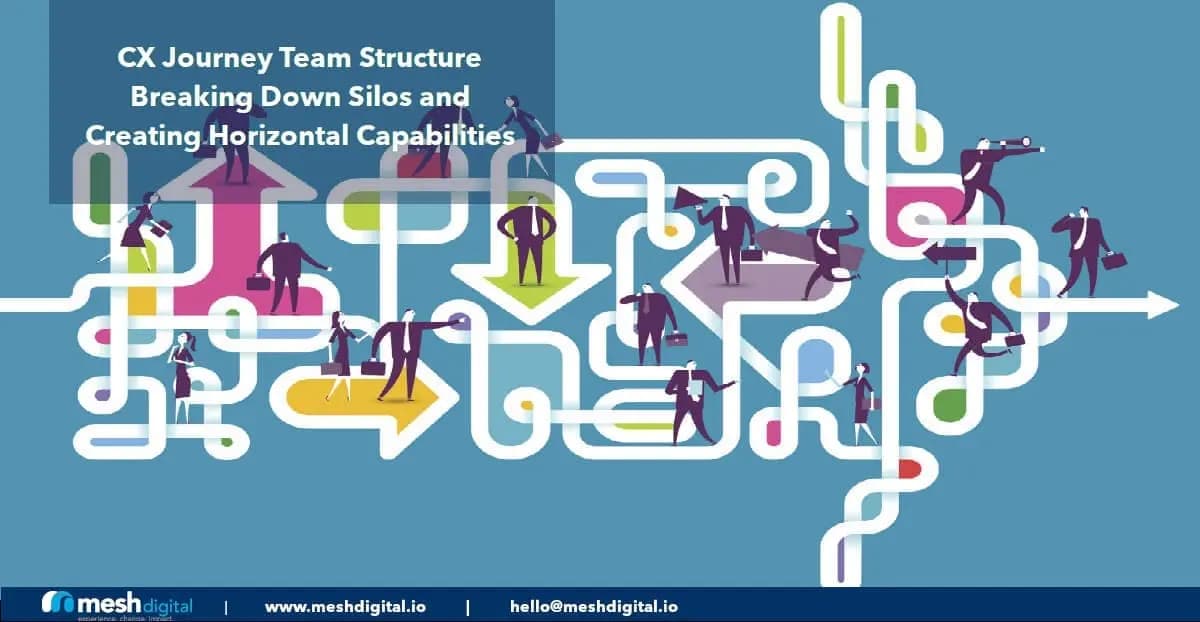Transformation Tips Series: Structuring CX Journey Teams in a Customer Led Digital Transformation
Structuring customer journey teams as one of the first horizontal capabilities defined as part of the customer experience organization can go a long way towards the goal of breaking down problematic, legacy silos. Here are some steps to consider when thinking about organizing customer journey teams:

As we build on last week’s Transformation Tip to Break Down Organizational Silos During CX Led Digital Transformation. Structuring customer journey teams as one of the first horizontal capabilities defined as part of the customer experience organization can go a long way towards the goal of breaking down problematic, legacy silos. Here are some steps to consider when thinking about organizing customer journey teams:
- Define the scope and purpose of the customer journey teams: Customer journey teams should be focused on improving the customer experience across all touchpoints, full stop. This means ensuring they have remit and are empowered across digital and non-digital touchpoints and are held responsible and accountable for end-to-end customer journeys. Define the scope of their work as such and make sure it aligns with the overall goals of the customer experience organization, while laddering up to corporate strategic objectives.
- Identify key stakeholders: Customer journey teams should ideally include representatives from all areas of the enterprise that impact the customer journey, including but not limited to marketing, sales, customer service, product development, and Technology. Inclusion and the multiple lenses around how to meet the wants, needs, and pain points of the customer will enrich the customer journey, ensuring the full value chain participates in driving business outcomes and customer satisfaction.
- Assign clear roles and responsibilities: Clearly define the roles and responsibilities of each team member, clearing any hurdles for each role to be successful in an empowered role. This helps ensure that everyone understands their contribution to the team and the organization, while leadership sets a glide path for each role’s success.
- Establish a governance structure: Establish a lightweight governance structure that outlines how decisions will be made, how issues will be escalated, and how progress will be measured. This will help ensure that the team operates efficiently and effectively and can be held both responsible and accountable. Good governance will be a strategic enabler, while bad governance will be a hinderance. Ensuring the right balance will be critical to support transformational success.
- Develop customer personas: Leverage direct customer feedback, eliminating the penchant that many organizations and leaders have, which is to act as proxies on behalf of their customers. Directly gleaned wants, needs, pains, and opportunities using strong, unbiased research tools, methods, and researchers should directly inform customer personas that represent the swath of customers a firm has or wants to have. These personas help build empathy for your customers and inform customer journey teams where within the end-to-end journey there are key moments that matter to help influence positive customer experiences.
- Develop a customer journey map: At a minimum develop a customer journey map, ideally an end-to-end journey that outlines the various touchpoints and interactions a customer has with the organization. This will help the team identify areas where the customer experience can be improved, interactions a between functional groups are needed and what capabilities need to be delivered.
- Prioritize opportunities: Prioritize opportunities for improvement based on potential impact on the customer experience and the organization's goals. This will help the team focus their efforts on the most important areas.
- Develop and execute initiatives: Develop and execute initiatives that will improve the customer experience at each touchpoint. By way of example, this may include improving website functionality, simplifying a checkout process, or providing more personalized service and support.
- Measure and track progress: Measure and track progress towards the goals of the customer journey team. Use metrics such as customer satisfaction scores, Net Promoter Score (NPS), and customer retention rates to monitor progress and adjust the team's approach as needed. Instrumenting the entire customer journey so that the firm can measure, monitor, and manage the preferred outcomes will again be critical to ensure transformational and business success.
- Continuously iterate and improve: Continuously iterate and improve the customer journey based on feedback from real customers and the results of the team's initiatives. Regularly revisit the customer journey map to ensure it accurately reflects the customer experience and identifies areas for improvement, aligning investment strategies to what works and defunding what doesn’t.
Here at Mesh Digital, LLC we're fortunate to have helped global clients, across sectors define and realize the value of breaking down organizational silos while building E2E Digital Strategies. From performing research, to developing Personas, Journeys, or Service Blueprints, to bootstrapping CX teams, we bring the power of real-world experience to bear on behalf of our clients. To unlock the potential of a modern business for your firm fueled by Digital Strategies and Tech, please feel free to reach out.
